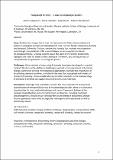Files in this item
Temporal β diversity—a macroecological perspective
Item metadata
| dc.contributor.author | Magurran, Anne E. | |
| dc.contributor.author | Dornelas, Maria | |
| dc.contributor.author | Moyes, Faye | |
| dc.contributor.author | Henderson, Peter A. | |
| dc.date.accessioned | 2020-11-10T00:38:23Z | |
| dc.date.available | 2020-11-10T00:38:23Z | |
| dc.date.issued | 2019-11-10 | |
| dc.identifier | 263192031 | |
| dc.identifier | 5a7b03fe-e5cb-4f14-a05d-5ec57840517c | |
| dc.identifier | 85075068740 | |
| dc.identifier | 000495357800001 | |
| dc.identifier.citation | Magurran , A E , Dornelas , M , Moyes , F & Henderson , P A 2019 , ' Temporal β diversity—a macroecological perspective ' , Global Ecology and Biogeography , vol. Early View . https://doi.org/10.1111/geb.13026 | en |
| dc.identifier.issn | 1466-822X | |
| dc.identifier.other | RIS: urn:6171342D2E80B23D25B9F6859F4D2D7C | |
| dc.identifier.other | ORCID: /0000-0002-0036-2795/work/64697683 | |
| dc.identifier.other | ORCID: /0000-0001-9687-0593/work/64697905 | |
| dc.identifier.uri | https://hdl.handle.net/10023/20937 | |
| dc.description | Authors acknowledge the following funding: European Research Council (ERC) Advanced Grant (AdG) BioTIME (250198) and ERC Proof of Concept (PoC) BioCHANGE (727440) to AEM. | en |
| dc.description.abstract | Issue Biodiversity change, that is how the taxonomic identities and abundances of species in ecological systems are changing over time, has two facets: temporal α diversity and temporal β diversity. To date, temporal α diversity has received most attention even though compositional shifts in assemblages exceed expectations based on ecological theory. Growing concern about the state of the world’s biodiversity highlights the need for better understanding of the extent, and consequences, of compositional reorganization in ecological systems. Challenges Most methods of measuring β diversity have been developed in a spatial context. We discuss the additional challenges involved in the assessment of temporal change, summarize existing methodological approaches, highlight the importance of establishing relevant baselines, and identify the need for appropriate null models of temporal β diversity. Given considerable potential for research on the macroecology of temporal β diversity we suggest future directions and challenges. Conclusions Although data availability remains the main impediment to improved quantification of temporal β diversity at macroecological scales, there are substantial opportunities for improved methodology and theory. Taxonomic β diversity has received most attention, but other dimensions of diversity, including functional and phylogenetic, should be part of integrated assessments of biodiversity change. Future approaches need to be ecologically meaningful and interpretable as well as statistically robust. | |
| dc.format.extent | 627834 | |
| dc.language.iso | eng | |
| dc.relation.ispartof | Global Ecology and Biogeography | en |
| dc.subject | Anthropocene | en |
| dc.subject | Baseline change | en |
| dc.subject | Biodiversity theory | en |
| dc.subject | Biogeography | en |
| dc.subject | Compositional shifts | en |
| dc.subject | Null models | en |
| dc.subject | Richness | en |
| dc.subject | Temporal α diversity | en |
| dc.subject | Temporal β diversity | en |
| dc.subject | Temporal turnover | en |
| dc.subject | QH301 Biology | en |
| dc.subject | DAS | en |
| dc.subject.lcc | QH301 | en |
| dc.title | Temporal β diversity—a macroecological perspective | en |
| dc.type | Journal article | en |
| dc.contributor.sponsor | European Research Council | en |
| dc.contributor.sponsor | European Research Council | en |
| dc.contributor.institution | University of St Andrews. School of Biology | en |
| dc.contributor.institution | University of St Andrews. Centre for Biological Diversity | en |
| dc.contributor.institution | University of St Andrews. Scottish Oceans Institute | en |
| dc.contributor.institution | University of St Andrews. Institute of Behavioural and Neural Sciences | en |
| dc.contributor.institution | University of St Andrews. St Andrews Sustainability Institute | en |
| dc.contributor.institution | University of St Andrews. Centre for Research into Ecological & Environmental Modelling | en |
| dc.contributor.institution | University of St Andrews. Fish Behaviour and Biodiversity Research Group | en |
| dc.contributor.institution | University of St Andrews. Marine Alliance for Science & Technology Scotland | en |
| dc.identifier.doi | 10.1111/geb.13026 | |
| dc.description.status | Peer reviewed | en |
| dc.date.embargoedUntil | 2020-11-10 | |
| dc.identifier.grantnumber | 250189 | en |
| dc.identifier.grantnumber | 727440 | en |
This item appears in the following Collection(s)
Items in the St Andrews Research Repository are protected by copyright, with all rights reserved, unless otherwise indicated.

